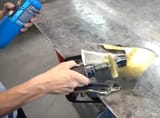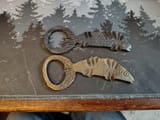Brass Coating Metal
brassy.png
md5: cdbbdbc8... 🔍

Hey /diy/, I was looking into electroplating for a retarded autistic project I want to undertake, and my research so far is showing that doing actual brass electroplating would be sorta untenable for me, but then I ran into this sort of brass coating thing.
Basically you heat the steel up fairly high (I think about 1,100 F, 600ish C) and then use a brass wire brush to on the steel, gradually layering on more and more brass as you go.
Has anyone ever tried this? How well did it work for you? Do you think it would work well on small items like pocket watches or small features like engraving very well?
Basically you heat the steel up fairly high (I think about 1,100 F, 600ish C) and then use a brass wire brush to on the steel, gradually layering on more and more brass as you go.
Has anyone ever tried this? How well did it work for you? Do you think it would work well on small items like pocket watches or small features like engraving very well?
